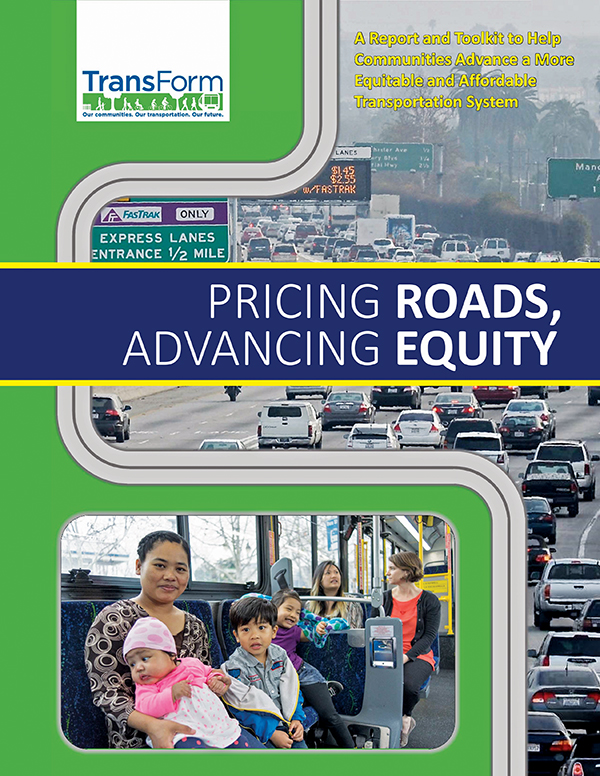
TransForm published the report Pricing Roads, Advancing Equity earlier this year. Image courtesy TransForm.
In many parts of the Bay Area driving is more like plodding, with heavy feet on the brakes because of record-level gridlock on roads and streets.
Given no sign these conditions will let up, San Francisco is joining the ranks of other large U.S. cities and considering congestion pricing — a possible toll to drive in the downtown area during peak periods. The aim is that, when faced with a fee, drivers will re-think their travel plans, hop on a bike, or ride a bus or train.
As the fifth-most congested city in the world, San Francisco drivers lose nearly 80 hours a year to congestion, the heavy flow of which contributes to air pollution, hurts residents’ quality of life, and results in lost productivity from an economic perspective.
The board of supervisors at the San Francisco County Transportation Authority (SFCTA), which oversees delivery of the Proposition K half-cent local transportation sales tax program and New Expenditure Plan, agreed during a February 12 meeting to invest $500,000 to study tolling in the northeastern part of the city. Social and racial equity will be emphasized in the work, vetting various charges, discounts, subsidies, and incentives.
“We have a system that is stratified by income, as well as race and ethnicity,” said Jeff Hobson, outgoing deputy director for planning at SFCTA. “Our goal would be to pursue an equitable plan by having a congestion pricing fee that uses funds paid by drivers … to invest into expanding transit and improving it to be safer for walking and biking.”
SFCTA first studied congestion charges for downtown in 2010. It determined then that a “cordon,” or a fee charged when a car enters or exits a defined area, would be the best bet for the city’s northeast quadrant, Hobson said. That territory includes the downtown area going as far west as Laguna Street and as far south as 18th Street, and bound by water on the other edges.
But sluggish recovery from the Great Recession curbed the appetite for “taking such a bold step” nearly a decade ago, Hobson said. Business community input also compelled officials to explore whether similar effects could be achieved by changing prices on parking, among other alternatives later studied.
Today, congestion pricing is not as widespread as other approaches like express lanes, but they are gaining some traction on big city policy agendas due to heavy traffic congestion and related climate concerns, said Stuart Cohen, outgoing executive director at TransForm and co-author of the report Pricing Roads, Advancing Equity.
Three West Coast cities — Los Angeles, Portland, and Seattle — are actively exploring whether congestion pricing should hit their roads. Overseas, Stockholm, Singapore, and Milan employ cordon pricing to enter their downtowns.
SFCTA’s latest congestion pricing study will build off a toolkit that’s part of the Pricing Roads, Advancing Equity report from TransForm and the Natural Resources Defense Council, Hobson said. The toolkit offers cities a road pricing framework that ensures fair transportation polices and investments.
“With rents through the roof, we need to minimize the cost of transportation and that will help more people stay in place and stay in the region,” Cohen said.
By definition, equitable transportation options should increase access to high-quality mobility options that are affordable, accessible, safe, reliable, and efficient, advocates said. Options also should emphasize air pollution reductions because, in general, low-income residents and communities of color tend to suffer disproportionately.
“Congestion pricing is an opportunity to come to terms with the reality that our reliance on cars is bad for the economy and society,” said Hana Creger, environmental equity program manager at The Greenlining Institute, an Oakland-based policy and research group.
Despite the opportunity, comments from San Francisco Supervisor Rafael Mandelman made during the February 12 meeting point to mixed feelings at the planning level.
Putting a congestion pricing strategy in place is “a heavy lift,” said Mandelman, citing a Dignity Health CityBeat poll from the San Francisco Chamber of Commerce showing 30 percent of residents support the approach. But when car-sharing services are increasing the use of already busy streets, congestion pricing is “one of the few potential tools we may have left,” Mandelman countered.
Tolling also has been proposed to enter and exit San Francisco’s Treasure Island, in addition to looking at a reservation and pricing system to manage the flow of traffic on tourist-laden Lombard Street.
There’s also the possibility of adding State Route 37 to the Bay Area Toll Authority’s (BATA) bridge toll program, signaling toll talk going forward, based on a recent memorandum of understanding signed by the transportation authorities of Marin, Napa, Sonoma, and Solano counties. The move to BATA would require legislation.
Still, these examples aren’t necessarily an indication other congested corridors will start moving in the same direction, especially given high development and operational costs, Cohen said. In fact, the road pricing approach with broader regional reach is express lanes in which solo drivers who choose to pay a toll may use them. Express lanes are free for carpools, buses, and motorcycles.
Bay Area transportation agencies are creating a 600-mile network of express lanes that will be completed in 2035. The Metropolitan Transportation Commission (MTC) will eventually operate 270 miles of the network.
“What we see consistently is a speed and time advantage in the express lane,” said John Goodwin, MTC spokesperson. For example, on Interstate 680 in Contra Costa County there is an 8-mile speed advantage in the express lane during the peak hour northbound in the afternoon, compared to the general purpose lane.
Back in San Francisco, SFCTA envisions the congestion pricing study as an 18-month effort, based on a schedule included in December 4 meeting materials. But those published dates could slip since officials are still seeking funding for the effort beyond the $500,000 SFCTA board commitment, $400,000 from MTC, and revenue from city development impact fees, Hobson said.
The study will include rounds of community engagement to gather equity and economic input. While a $3 toll was floated in SFCTA’s 2010 study, officials have not settled on an amount to consider going forward, Hobson said.
The crux of the work is about “how do we design a system that makes the transportation network work better and fair,” he added.
Cecily O’Connor covers transportation for the Monitor.

